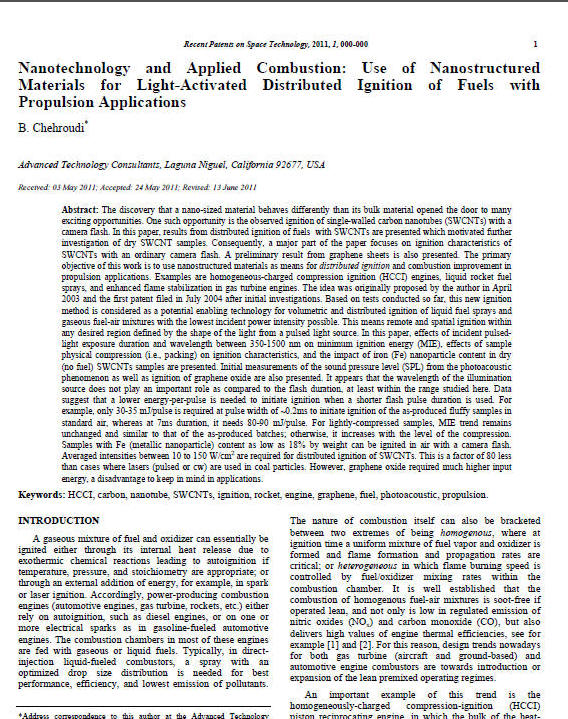Nanotechnology and Applied
Combustion: Use of Nanostructured Materials for Light-Activated
Distributed Ignition of Fuels with Propulsion Applications:
http://www.eurekaselect.com/95965/article/nanotechnology-and-applied-combustion-use-nanostructured-materials-light-activated
ABSTRACT
The discovery that a nanostructured
material behaves differently than the bulk material opened the door
to many exciting opportunities.
 One
such opportunity is the observed ignition of single-walled carbon
nanotubes (SWCNTs) with a camera flash. In this paper, results from
distributed ignition of fuels with SWCNTs are presented which
motivated further investigation of dry SWCNT samples. Consequently,
a major part of the paper focuses on ignition characteristics of
SWCNTs with an ordinary camera flash. A preliminary result from
graphene sheets is also presented. The primary objective of this
work is to use nanostructured materials as means for distributed
ignition and combustion improvement in propulsion applications.
Examples are homogeneous-charged compression ignition (HCCI)
engines, liquid rocket fuel sprays, and enhanced flame stabilization
in gas turbine engines. The idea was originally proposed by the
author in April 2003 and the first patent filed in July 2004 after
initial investigations. Based on tests conducted so far, this new
ignition method is considered as a potential enabling technology for
volumetric and distributed ignition of liquid fuel sprays and
gaseous fuel-air mixtures with the lowest incident power intensity
possible. This means remote and spatial ignition within any desired
region defined by the shape of the light from a pulsed light source.
In this paper, effects of incident pulsed-light exposure duration
and wavelength between 350-1500 nm on minimum ignition energy (MIE),
effects of sample physical compression (i.e., packing) on ignition
characteristics, and the impact of iron (Fe) nanoparticle content in
dry (no fuel) SWCNTs samples are presented. Initial measurements of
the sound pressure level (SPL) from the photoacoustic phenomenon as
well as ignition of graphene oxide are also presented. It appears
that the wavelength of the illumination source does not play an
important role as compared to the flash duration, at least within
the range studied here. Data suggests that a lower energy-per-pulse
is needed to initiate ignition when a shorter flash pulse duration
is used. For example, only 30-35 mJ/pulse is required at pulse width
of ~0.2ms to initiate ignition of the as-produced fluffy samples in
standard air, whereas at 7ms duration, it needs 80-90 mJ/pulse . For
lightly-compressed samples, MIE trend remains unchanged and similar
to that of the as-produced batches; otherwise, it increases with the
level of the compression. Samples with Fe (metallic nanoparticle)
content as low as 18% by weight can be ignited in air with a camera
flash. Averaged intensities between 10 to 150 W/cm2 are required for
distributed ignition of SWCNTs. This is a factor of 80 less than
cases where lasers (pulsed or cw) are used in coal particles.
However, graphene oxide required much higher input energy, a
disadvantage to keep in mind in applications. One
such opportunity is the observed ignition of single-walled carbon
nanotubes (SWCNTs) with a camera flash. In this paper, results from
distributed ignition of fuels with SWCNTs are presented which
motivated further investigation of dry SWCNT samples. Consequently,
a major part of the paper focuses on ignition characteristics of
SWCNTs with an ordinary camera flash. A preliminary result from
graphene sheets is also presented. The primary objective of this
work is to use nanostructured materials as means for distributed
ignition and combustion improvement in propulsion applications.
Examples are homogeneous-charged compression ignition (HCCI)
engines, liquid rocket fuel sprays, and enhanced flame stabilization
in gas turbine engines. The idea was originally proposed by the
author in April 2003 and the first patent filed in July 2004 after
initial investigations. Based on tests conducted so far, this new
ignition method is considered as a potential enabling technology for
volumetric and distributed ignition of liquid fuel sprays and
gaseous fuel-air mixtures with the lowest incident power intensity
possible. This means remote and spatial ignition within any desired
region defined by the shape of the light from a pulsed light source.
In this paper, effects of incident pulsed-light exposure duration
and wavelength between 350-1500 nm on minimum ignition energy (MIE),
effects of sample physical compression (i.e., packing) on ignition
characteristics, and the impact of iron (Fe) nanoparticle content in
dry (no fuel) SWCNTs samples are presented. Initial measurements of
the sound pressure level (SPL) from the photoacoustic phenomenon as
well as ignition of graphene oxide are also presented. It appears
that the wavelength of the illumination source does not play an
important role as compared to the flash duration, at least within
the range studied here. Data suggests that a lower energy-per-pulse
is needed to initiate ignition when a shorter flash pulse duration
is used. For example, only 30-35 mJ/pulse is required at pulse width
of ~0.2ms to initiate ignition of the as-produced fluffy samples in
standard air, whereas at 7ms duration, it needs 80-90 mJ/pulse . For
lightly-compressed samples, MIE trend remains unchanged and similar
to that of the as-produced batches; otherwise, it increases with the
level of the compression. Samples with Fe (metallic nanoparticle)
content as low as 18% by weight can be ignited in air with a camera
flash. Averaged intensities between 10 to 150 W/cm2 are required for
distributed ignition of SWCNTs. This is a factor of 80 less than
cases where lasers (pulsed or cw) are used in coal particles.
However, graphene oxide required much higher input energy, a
disadvantage to keep in mind in applications.


Back to Top of This Page
NOTE:
Contact Advanced Technology
Consultants for consulting needs and opportunities in this
area
Copyright 2017 -
Advanced Technology Consultants- All Rights
Reserved
|




